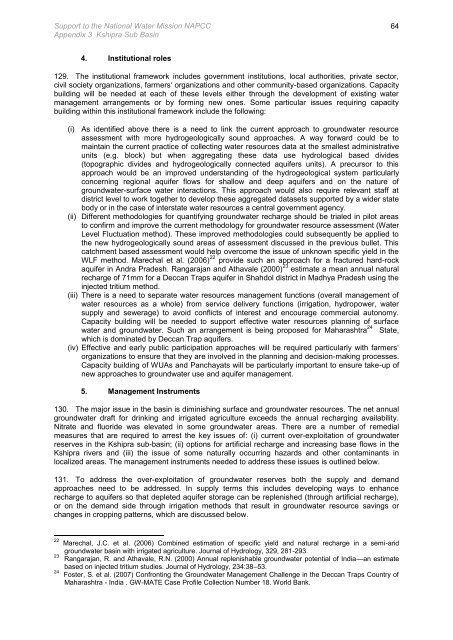Kshipra Sub Basin - Asian Development Bank
Kshipra Sub Basin - Asian Development Bank
Kshipra Sub Basin - Asian Development Bank
You also want an ePaper? Increase the reach of your titles
YUMPU automatically turns print PDFs into web optimized ePapers that Google loves.
Support to the National Water Mission NAPCC<br />
Appendix 3 <strong>Kshipra</strong> <strong>Sub</strong> <strong>Basin</strong><br />
4. Institutional roles<br />
129. The institutional framework includes government institutions, local authorities, private sector,<br />
civil society organizations, farmers‘ organizations and other community-based organizations. Capacity<br />
building will be needed at each of these levels either through the development of existing water<br />
management arrangements or by forming new ones. Some particular issues requiring capacity<br />
building within this institutional framework include the following:<br />
(i) As identified above there is a need to link the current approach to groundwater resource<br />
assessment with more hydrogeologically sound approaches. A way forward could be to<br />
maintain the current practice of collecting water resources data at the smallest administrative<br />
units (e.g. block) but when aggregating these data use hydrological based divides<br />
(topographic divides and hydrogeologically connected aquifers units). A precursor to this<br />
approach would be an improved understanding of the hydrogeological system particularly<br />
concerning regional aquifer flows for shallow and deep aquifers and on the nature of<br />
groundwater-surface water interactions. This approach would also require relevant staff at<br />
district level to work together to develop these aggregated datasets supported by a wider state<br />
body or in the case of interstate water resources a central government agency.<br />
(ii) Different methodologies for quantifying groundwater recharge should be trialed in pilot areas<br />
to confirm and improve the current methodology for groundwater resource assessment (Water<br />
Level Fluctuation method). These improved methodologies could subsequently be applied to<br />
the new hydrogeologically sound areas of assessment discussed in the previous bullet. This<br />
catchment based assessment would help overcome the issue of unknown specific yield in the<br />
WLF method. Marechal et al. (2006) 22 provide such an approach for a fractured hard-rock<br />
aquifer in Andra Pradesh. Rangarajan and Athavale (2000) 23 estimate a mean annual natural<br />
recharge of 71mm for a Deccan Traps aquifer in Shahdol district in Madhya Pradesh using the<br />
injected tritium method.<br />
(iii) There is a need to separate water resources management functions (overall management of<br />
water resources as a whole) from service delivery functions (irrigation, hydropower, water<br />
supply and sewerage) to avoid conflicts of interest and encourage commercial autonomy.<br />
Capacity building will be needed to support effective water resources planning of surface<br />
water and groundwater. Such an arrangement is being proposed for Maharashtra 24 State,<br />
which is dominated by Deccan Trap aquifers.<br />
(iv) Effective and early public participation approaches will be required particularly with farmers‘<br />
organizations to ensure that they are involved in the planning and decision-making processes.<br />
Capacity building of WUAs and Panchayats will be particularly important to ensure take-up of<br />
new approaches to groundwater use and aquifer management.<br />
5. Management Instruments<br />
130. The major issue in the basin is diminishing surface and groundwater resources. The net annual<br />
groundwater draft for drinking and irrigated agriculture exceeds the annual recharging availability.<br />
Nitrate and fluoride was elevated in some groundwater areas. There are a number of remedial<br />
measures that are required to arrest the key issues of: (i) current over-exploitation of groundwater<br />
reserves in the <strong>Kshipra</strong> sub-basin; (ii) options for artificial recharge and increasing base flows in the<br />
<strong>Kshipra</strong> rivers and (iii) the issue of some naturally occurring hazards and other contaminants in<br />
localized areas. The management instruments needed to address these issues is outlined below.<br />
131. To address the over-exploitation of groundwater reserves both the supply and demand<br />
approaches need to be addressed. In supply terms this includes developing ways to enhance<br />
recharge to aquifers so that depleted aquifer storage can be replenished (through artificial recharge),<br />
or on the demand side through irrigation methods that result in groundwater resource savings or<br />
changes in cropping patterns, which are discussed below.<br />
22 Marechal, J.C. et al. (2006) Combined estimation of specific yield and natural recharge in a semi-arid<br />
groundwater basin with irrigated agriculture. Journal of Hydrology, 329, 281-293.<br />
23 Rangarajan, R. and Athavale, R.N. (2000) Annual replenishable groundwater potential of India—an estimate<br />
based on injected tritium studies. Journal of Hydrology, 234:38–53.<br />
24 Foster, S. et al. (2007) Confronting the Groundwater Management Challenge in the Deccan Traps Country of<br />
Maharashtra - India . GW-MATE Case Profile Collection Number 18. World <strong>Bank</strong>.<br />
64
















